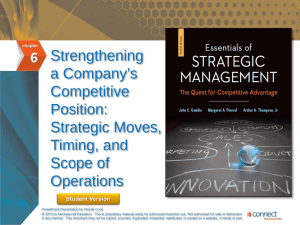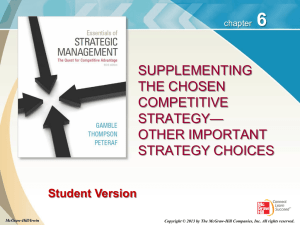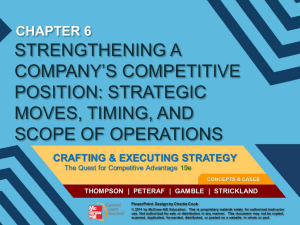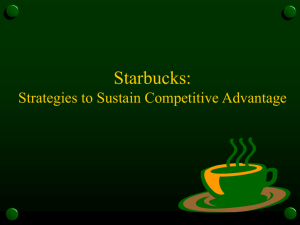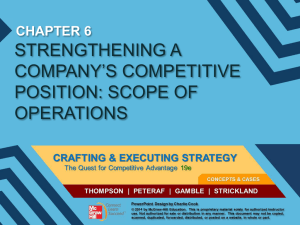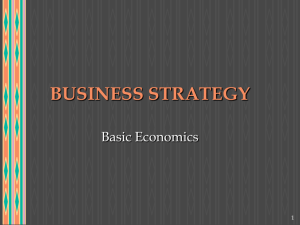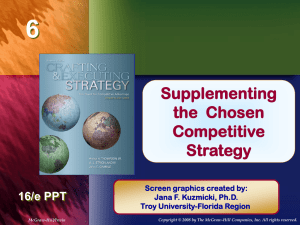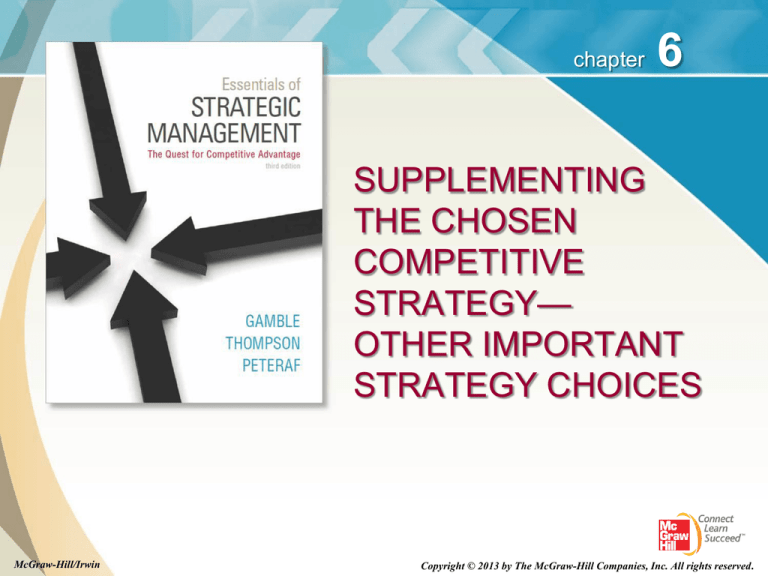
chapter
6
SUPPLEMENTING
THE CHOSEN
COMPETITIVE
STRATEGY—
OTHER IMPORTANT
STRATEGY CHOICES
McGraw-Hill/Irwin
Copyright © 2013 by The McGraw-Hill Companies, Inc. All rights reserved.
LO1 Learn whether and when to pursue offensive
strategic moves to improve a company’s
market position.
LO2 Learn whether and when to employ defensive
strategies to protect the company’s market
position.
LO3 Recognize when being a first mover or a fast
follower or a late mover can lead to
competitive advantage.
LO4 Learn the advantages and disadvantages of
extending a company’s scope of operations
via vertical integration.
6-2
(cont’d)
LO5 Understand the conditions that favor farming
out certain value chain activities to outside
parties.
LO6 Gain an understanding of how strategic
alliances and collaborative partnerships can
substitute for mergers and acquisitions or
vertical integration.
LO7 Become aware of the strategic benefits and
risks of mergers and acquisitions.
6-3
Choosing Strategy Actions
that Complement a Firm’s
Competitive Approach
Decisions regarding the firm’s operating scope and
how to best strengthen its market standing must be
made:
Whether and when to go on the offensive and initiate aggressive
strategic moves to improve the firm’s market position.
Whether and when to employ defensive strategies to protect the
firm’s market position.
When to undertake strategic moves based upon whether it is
advantageous to be a first mover or a fast follower or a late
mover.
6-4
Choosing Strategy Actions
that Complement a Firm’s
Competitive Approach (cont’d)
Decisions regarding the firm’s operating scope and
how to best strengthen its market standing must be
made:
Whether to integrate backward or forward into more stages of the
industry value chain.
Which value chain activities, if any, should be outsourced.
Whether to enter into strategic alliances or partnership
arrangements with other enterprises.
Whether to bolster the firm’s market position by merging with or
acquiring another company in the same industry.
6-5
Launching Strategic Offensives to
Improve a Company’s Market Position
Aggressive
strategic offensives are called
for when a firm:
Spots opportunities to gain profitable market share
at the expense of rivals
Has no choice but to try to whittle away at a strong
rival’s competitive advantage
Can reap the benefits a competitive edge offers—a
leading market share, excellent profit margins, and
rapid growth
The
best offensives use a firm’s resource
strengths to attack its rivals’ weaknesses.
6-6
Choosing the Basis for
Competitive Attack
Attack the competitive
weaknesses of rivals
Offer an equal or better
product at a lower price
Adopt and improve on
good ideas of other firms
Principal
Offensive
Strategy
Options
Attack profitable market
segments of key rivals
Pursue continuous
product innovation
Capture unoccupied or
less contested markets
Leapfrog competitors to
be the first to market
Use hit-and-run or guerrilla
marketing tactics
Launch a preemptive strike
on a market opportunity
6-7
Principal Offensive Strategy Options
Attacking the competitive weaknesses of rivals
Offering an equally good or better product at a lower
price
Pursuing continuous product innovation
Leapfrogging competitors by being the first to
market with next generation technology or products
Adopting and improving on the good ideas of other
companies (rivals or otherwise)
Deliberately attacking those market segments where
a key rival makes big profits
Maneuvering around competitors to capture
unoccupied or less contested market territory
6-8
Principal Offensive Strategy Options (cont’d)
Using hit-and-run or guerrilla warfare tactics to grab
sales and market share from complacent or
distracted rivals
Launching a preemptive strike to capture a rare
opportunity or secure an industry’s limited
resources
Secure the best distributors in a particular geographic region or
country
Secure the most favorable retail locations
Tie up the most reliable, high-quality suppliers via exclusive
partnerships, long-term contracts, or even acquisition
6-9
Choosing Which Rivals to Attack
Market leaders that are vulnerable
Best Targets
for Offensive
Attacks
Runner-up firms with weaknesses in
areas where the challenger is strong
Struggling enterprises that are on
the verge of going under
Small local and regional firms with
limited capabilities
6-10
Blue Ocean Strategy—
A Special Kind of Offensive
Involves
a firm seeking sizable and durable
competitive advantage by abandoning its
existing markets and, then, inventing a new
industry or distinctive market segment in
which that firm has exclusive access to new
demand.
By “reinventing the circus,” Cirque du Soleil annually
attracts an audience of millions of people who typically
do not attend circus events.
6-11
Core Concept
Blue ocean strategies offer growth in
revenues and profits by discovering or
inventing new industry segments that
create altogether new demand.
6-12
Using Defensive Strategies to Protect
a Company’s Market Position and
Competitive Advantage
Defensive
strategies help fortify a
competitive position by:
Lowering the risk of being attacked.
Weakening the impact of any attack that occurs.
Influencing challengers to redirect their competitive
efforts toward other rivals.
Good
defensive strategies help protect
competitive advantage but rarely are the
basis for creating it.
6-13
Blocking the Avenues
Open to Challengers
Maintain economypriced models
Introduce new
features
Add new models
Broaden product
line to fill vacant
niches
Defending a
Competitive
Position
Announce new
products or price
changes
Grant volume
discounts or better
financing terms
6-14
Blocking the Avenues
Open to Challengers
Introduce new features
Add new models
Broaden product line to fill vacant niches
Maintain economy-priced models
Make early announcements about upcoming new
products or planned price changes
Grant volume discounts or better financing terms to
dealers and distributors to discourage them from
experimenting with other suppliers
6-15
Signaling Challengers that
Retaliation Is Likely
Publicly announcing management’s
strong commitment to maintain the
firm’s present market share
Dissuading
or diverting
competitors
Publicly committing the firm to a
policy of matching competitors’
terms or prices
Maintaining a war chest of cash
and marketable securities
Making a strong counterresponse to
weak competitor moves to enhance
the firm’s image as a tough defender
6-16
Signaling Challengers that
Retaliation Is Likely
Publicly
announce management’s strong
commitment to maintain the firm’s present
market share
Publicly commit firm to policy of
matching rivals’ terms or prices
Maintain war chest of cash reserves
Make occasional counterresponse
to moves of weaker rivals
6-17
Timing a Company’s Offensive
and Defensive Strategic Moves
When
to make a strategic move is often as
crucial as what move to make.
First-mover advantages arise when:
Pioneering helps build a firm’s image and reputation
with buyers
Early commitments (technology, market channels)
produce an absolute cost advantage over rivals
First-time customers remain strongly loyal in making
repeat purchases
Moving first constitutes a preemptive strike, making
imitation extra hard or unlikely
6-18
Core Concept
Because of first-mover advantages
and disadvantages, competitive
advantage can spring from when a
move is made as well as from what
move is made.
6-19
The Potential for Late-Mover Advantages
or First-Mover Disadvantages
Moving
early can be a disadvantage (or fail
to produce an advantage) when:
Pioneering leadership is more costly than imitation
Innovators’ products are primitive, and do not live up
to buyer expectations
Potential buyers are skeptical about the benefits of
new technology/product of a first mover
Rapid changes in technology or buyer needs allow
followers to leapfrog pioneers
6-20
Deciding Whether to Be an Early Mover
or Late Mover
Key Issue:
Is the race to market leadership a marathon or a sprint?
Seeking first-mover competitive advantage
involves addressing several questions:
Does market takeoff depend on development of complementary
products or services not currently available?
Is new infrastructure required before buyer demand can surge?
Will buyers need to learn new skills or adopt new behaviors?
Are there influential competitors in a position to delay or derail
the efforts of a first mover?
6-21
Concepts and Connections 6.1
Amazon.Com’s First-Mover Advantage in Online Retailing
6-22
Vertical Integration: Operating Across
More Industry Value Chain Segments
Involves
extending a firm’s competitive and
operating scope within the same industry
Backward into sources of supply
Forward toward end users of final product
Can
aim at either full or partial integration
6-23
Core Concept
A vertically integrated firm is one that performs
value chain activities along more than one stage
of an industry’s overall value chain.
A vertical integration strategy has appeal only
if it significantly strengthens a firm’s competitive
position and/or boosts its profitability
6-24
Core Concept
Backward integration involves performing
industry value chain activities previously
performed by suppliers or other enterprises
engaged in earlier stages of the industry value
chain; forward integration involves performing
industry value chain activities closer to the end
user.
6-25
The Advantages of a Vertical
Integration Strategy
The
two best reasons for vertically
integrating into more value chain segments:
Strengthen the firm’s competitive position
Boost profitability
6-26
Integrating Backward to Achieve
Greater Competitiveness
For
backward integration to boost
profitability a firm must be able to:
Achieve the same scale economies
as outside suppliers
Match or beat suppliers’ production
efficiency with no drop in quality
6-27
When Backward Vertical Integration
Becomes a Consideration
When suppliers have large
profit margins
Backward
Vertical
Integration
Situations
When the item being supplied
is a major cost component
When the requisite technological skills
are easily mastered or acquired
When powerful suppliers are inclined
to raise prices at every opportunity
6-28
When Backward Vertical Integration
Becomes a Consideration
Potential
situations that create opportunities
for cost reduction through backward vertical
integration:
When suppliers have large profit margins
Where the item being supplied is a major cost
component
Where the requisite technological skills are easily
mastered or acquired
When powerful suppliers are inclined to raise prices at
every opportunity
6-29
Integrating Forward to Enhance
Competitiveness
Gain
better access to end users
Improve market visibility
Include the purchasing experience as a
differentiating feature
6-30
Forward Vertical Integration
and Internet Retailing
Direct
selling and Internet retailing have
appeal when there is no potential to:
Lower distribution costs
Gain a cost advantage over rivals
Produce higher margins
Allow for lower prices charged to end users
Competing
directly against distribution allies
can create channel conflict and signal a
weak commitment to dealers.
6-31
Disadvantages of a
Vertical Integration Strategy
Increases a firm’s capital investments in its industry
Increases a firm’s business risk if industry growth
and profits sour
Can slow the adoption of technical advances for vertically
integrated firms using older technologies and facilities
Results in less flexibility to accommodate changing buyer
preferences when a new product design requires parts
a firm doesn’t make in-house.
Creates capacity-matching problems among integrated
in-house component manufacturing units
May require development of radically different skills
and business capabilities
6-32
Concepts and Connections 6.2
American Apparel’s Vertical Integration Strategy
American Apparel—known for its hip line of basic garments
and its provocative advertisements—is no stranger to the
concept of “doing it all.” The Los Angeles-based casual
wear company has made both forward and backward
vertical integration a central part of its strategy, making it a
rarity in the fashion industry. Not only does it do all its own
fabric cutting and sewing, but it also owns several knitting
and dyeing facilities in Southern California, as well as a
distribution warehouse, a wholesale operation, and more
than 270 retail stores in 20 countries. American Apparel
even does its own clothing design, marketing, and
advertising, often using its employees as photographers
and clothing models.
Founder and CEO Dov Charney claims the company’s
vertical integration strategy lets American Apparel respond
more quickly to rapid market changes, allowing the
company to bring an item from design to its stores
worldwide in the span of a week. End-to-end coordination
also improves inventory control, helping prevent common
problems in the fashion business such as stock-outs and
steep markdowns. The company capitalizes on its
California-based vertically integrated operations by using
taglines such as “Sweatshop Free. Made in the USA” to
bolster its “authentic” image.
However, this strategy is not without risks and costs. In an
industry where 97 percent of goods are imported, American
Apparel pays its workers wages and benefits above the relatively
high mandated American minimum. Furthermore, operating in so
many key vertical chain activities makes it impossible to be
expert in all of them, and creates optimal scale and capacity
mismatches—problems with which the firm has partly dealt by
tapering its backward integration into knitting and dyeing. Lastly,
while the company can respond quickly to new fashion trends, its
vertical integration strategy may make it more difficult for the
company to scale back in an economic downturn or respond to
radical change in the industry environment. Ultimately, only time
will tell whether American Apparel will dilute or capitalize on its
vertical integration strategy in its pursuit of profitable growth.
Developed with John R. Moran.
Sources: American Apparel website, www.americanapparel.net,
accessed June 16, 2010; American Apparel investor presentation,
June 2009, http://files.shareholder.com/downloads/APP/
938846703x0x300331/3dd0b7ca-e458-45b8-8516-e25ca
272016d/NYC%20JUNE%202009.pdf; YouTube, “American Apparel—
Dov Charney Interview,” CBS News,
http://youtube.com/watch?v 5 hYqR8UIl8A4; and Christopher Palmeri,
“Living on the Edge at American Apparel,” BusinessWeek, June 27,
2005.
6-33
Outsourcing Strategies:
Narrowing the Scope of Operations
Outsourcing an activity is a consideration when:
It can be performed better or more cheaply by outside specialists.
It is not crucial to achieve a sustainable competitive advantage
and will not hollow out capabilities, core competencies, or
technical know-how of a firm.
It improves organizational flexibility and speeds time to market.
It reduces a firm’s risk exposure to changing technology and/or
buyer preferences.
It allows a firm to concentrate on its core business, leverage its
key resources and core competencies, and do even better what it
already does best.
6-34
Core Concept
Outsourcing involves contracting out certain
value chain activities to outside specialists and
strategic allies.
6-35
Outsourcing Strategies: Narrowing
the Scope of Operations (cont’d)
The
Big Risk of Outsourcing:
Farming out the wrong types of activities
Hollowing out strategically important capabilities
ultimately damages a firm’s competitiveness and longterm success in the marketplace
6-36
Strategic Alliances and Partnerships
Strategic
Alliance
Is a formal collaborative agreement in which two or
more firms join forces to achieve mutually beneficial
strategic outcomes:
A
strategically relevant collaboration
A joint contribution of resources
An assumption of a shared risk
An agreement to shared control
A recognition of mutual dependence
Is attractive in that it allows firms to bundle resources
and competencies that are more valuable in a joint
effort than when kept separate.
6-37
Core Concept
A strategic alliance is a formal agreement
between two or more companies to work
cooperatively toward some common objective.
A joint venture is a type of strategic alliance
that involves the establishment of an
independent corporate entity that is jointly
owned and controlled by the two partners.
6-38
Reasons for Firms to Enter
into Strategic Alliances
Expedite development
of new technologies
or products
Overcome technical
or manufacturing
expertise deficits
Bring together personnel
to create new skill sets
and capabilities
Improve supply chain
efficiency
Reasons for
Alliances
Gain economies of
scale in production
and/or marketing
Acquire or improve
market access via joint
marketing agreements
6-39
Reasons for Firms to Enter
into Strategic Alliances
To expedite development of new technologies or
products
To overcome deficits in technical or manufacturing
expertise
To bring together personnel of each partner to
create new skill sets and capabilities
To improve supply chain efficiency
To gain economies of scale in production and/or
marketing
To acquire or improve market access through joint
marketing agreements
6-40
Reasons for Firms to Continue
in Strategic Alliances
Alliances
are likely to be long-lasting when:
They involve collaboration with suppliers or
distribution allies.
Both parties conclude that continued collaboration
is in their mutual interest, perhaps because new
opportunities for learning are emerging.
Experience
indicates that:
Alliances stand a reasonable chance of helping a
firm reduce its competitive disadvantage but very
rarely have alliances proved a strategic option for
gaining a durable competitive edge over rivals.
6-41
Failed Strategic Alliances and
Cooperative Partnerships
Common
causes for the failure of 60–70%
of alliances each year:
Diverging objectives and priorities
An inability to work well together
Changing conditions that make the purpose of the
alliance obsolete
The emergence of more attractive technological paths
Marketplace rivalry between one or more allies
6-42
The Strategic Dangers of Relying on
Alliances for Essential Resources
and Capabilities
The
Achilles’ heel of alliances and
cooperative partnerships is becoming
dependent on other companies for essential
expertise and capabilities.
Ultimately,
a firm must develop its own
resources and capabilities to protect its
competitiveness and capabilities to build
and maintain its competitive advantage.
6-43
Merger and Acquisition Strategies
An
attractive strategic option for achieving
operating economies, strengthening
competencies, and opening avenues to new
market opportunities:
Merger
The
combining of two or more firms into a single entity, with the
newly created firm often taking on a new name
Acquisition
The
combination in which one firm, the acquirer, purchases
and absorbs the operations of another, the acquired firm
6-44
Typical Objectives of Mergers
and Acquisitions
1. To create a more cost-efficient operation
out of the combined firms
2. To expand a firm’s geographic coverage
3. To extend the firm’s business into new
product categories
4. To gain quick access to new technologies or
other resources and competitive capabilities
5. To lead the convergence of industries whose
boundaries are being blurred by changing
technologies and new market opportunities
6-45
Why Mergers and Acquisitions
Sometimes Fail to Produce
Anticipated Results
Cost savings are smaller than expected.
Gains in competitive capabilities take much longer
to realize or may never materialize.
Efforts to mesh the corporate cultures can stall
because of resistance from organization members.
Managers and employees at the acquired company
may continue to do things as they were done prior
to the acquisition.
Key employees of the acquired firm may leave.
6-46

